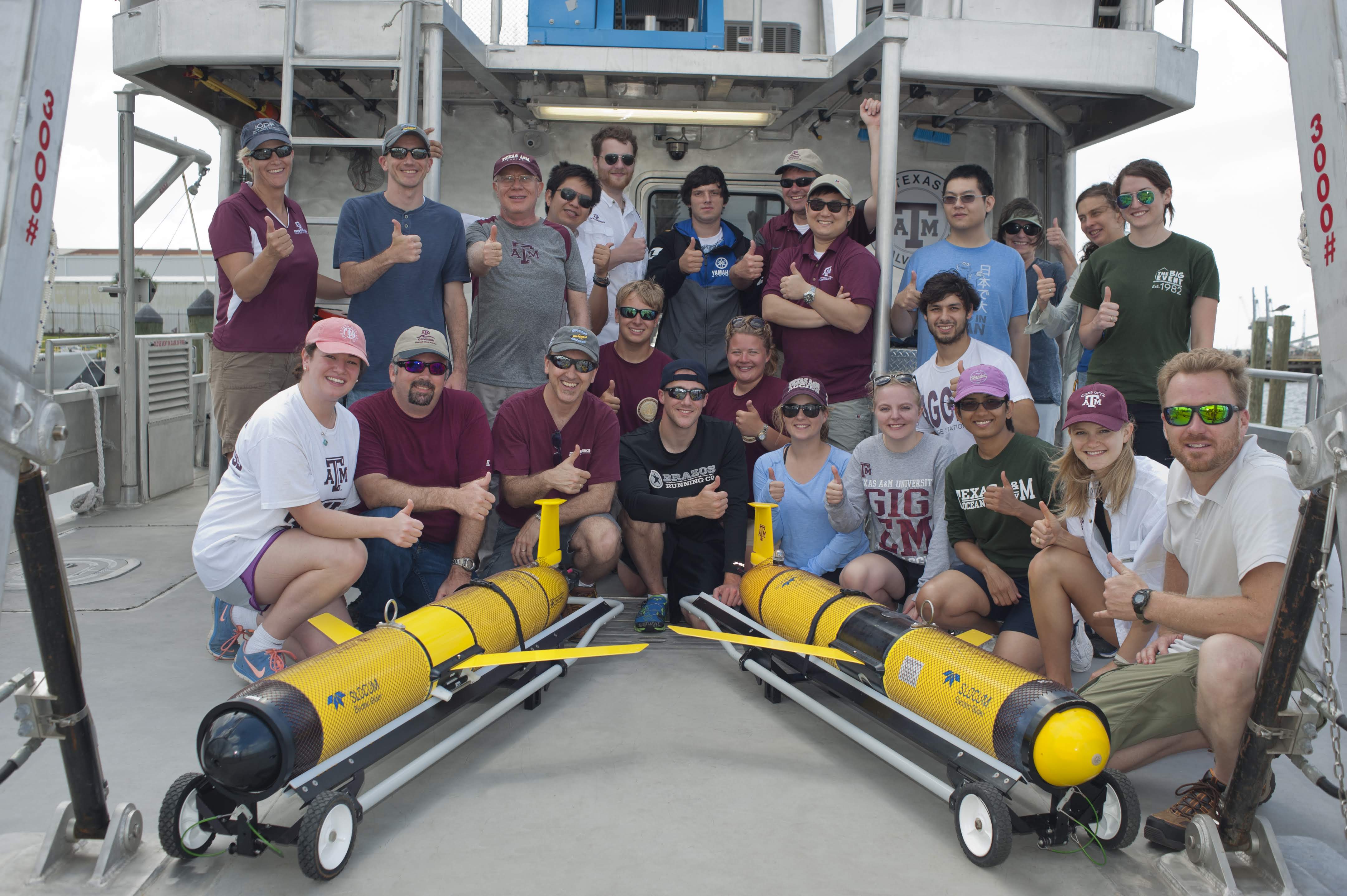Research Projects
Research Projects happening at GERG

Oceanographic (2017)
- GERG is operating the 8 Buoy Texas Automated Buoy System (TABS) funded by the Texas General Land Office (http://tabs.gerg.tamu) to aid in oil spill trajectory modelling off the Texas coast
- GERG is operating the Flower Garden Banks buoys N & V as part of a joint industry project (JIP) to protect the FGB from oil pollution events.
- GERG is operating four Teledyne G2 Buoyancy Gliders currently funded by the NOAA Hypoxia program, as well as the Texas Restore Act overseen by TCEQ. This involves many glider forays into the Gulf of Mexico to collect profiles of CTD, chlorophyll, CDOM, Turbidity and Dissolved Oxygen data.
- GERG is coordinating and installing a long range High Frequency Radar (HFR) network to measure current velocity and direction for the whole length of the Texas Coast, reaching 150 km offshore.
- GERG is incorporating current data from the radar network, with near surface currents measured from from TABS buoys and data from a surface wave glider (Autonaut) equipped with an Acoustic Doppler Current Profiler to get a comprehensive look at real-time current circulation on the Texas shelf.
- GERG is outfitting a Liquid Robotics SV3 Wave Glider with ocean acidification sensors to patrol the Flower Garden Banks in the northern GOM.
- GERG is building an Ocean Acidification Buoy to be deployed at the FGB in August 2017 with colleagues in the Oceanography Department, including surface and bottom mounted sensors.
- GERG is working with WHOI to outfit a surface wave glider to install a Flow Cytometer (Cytobot) to patrol the coast of Texas to detect Harmful Algal Blooms.
- GERG is designing a Ferry Box system to be used in the cooling water of ships of opportunity to determine the health of the Gulf of Mexico and the Eastern Mediterranean. A prototype system will be installed in the University of Southern Mississippi R/V Point Sur.
- GERG is conducting two cruises this summer to determine the water quality of coastal Texas funded by TCEQ as part of the Restore Act funding.
- GERG is designing and fabricating an Ocean Observing System (THEMO) for the University of Haifa, Israel. THEMO will consist of 3 surface to bottom sensor arrays as well as acoustically coupled subsurface arrays measuring CTD, Chlorophyll and current profiles
- GERG is designing and fabricating a 2.6 meter surface buoy and inductive mooring system in collaboration with Ocean University, China to be moored in the northern Kuroshio Extension.
- GERG is working jointly with the University of Southern Mississippi as invited by Shell to add new sensors to the Stones mooring in 3000 m in the Gulf of Mexico.
- GERG is working jointly with the University of Southern Mississippi to place a mooring in the international waters of the western Gulf of Mexico.
- GERG is managing the Shipboard technician program for UNOLS funded by the NSF as a 5 year co-operative agreement.
Environmental Sciences (2017)
- GERG with the Veterinary College and a number of other Departments at Texas A&M University became one of the 16 Superfund Research Centers funded by the National Institute of Environmental Health Science. The purpose is to investigate the mobilization of contaminants due to environmental disasters.
- GERG recently became part of the Mass Spectrometry Core at Texas A&M and is part of the Applied Mass Spectrometry Group.
- GERG recently was funded by various sources to obtain a number of new analytical instruments including an Agilent 6470 LC-MS/MS, an Agilent Ion Mobility Q-TOF LC/MS, an Agilent 7010 GC/MS/MS Triple Quadrupole EI system and a Leco GC/GC 2 dimensional system with a Time of Flight Mass spectrometer.
- GERG recently built a Biological Safety Laboratory (BSL2) laboratory to contain various human cell samples.
- GERG has been funded by the Gulf of Mexico Research Initiative to determine the sensitivity of deep-sea organisms to the effect of oil and oil dispersants
- GERG has been funded by the Gulf of Mexico Research Initiative through a subcontract with colleagues at Texas A&M Galveston, to determine the mechanism of Marine Oil Snow (MOS) formation during oil spills and the sedimentation of oil to the benthos.
- GERG has a contract with the Fish and Wildlife Foundation to analyze environmental materials for organic contaminants...
- GERG has a contract with Texas Department of State Health Services to investigate organic contaminants in fish tissues.
- GERG is working with the School of Public Health to determine the extent of airborne contaminants in homes of people in Manchester, Texas (Houston Ship Channel).
- GERG is working with the Baylor Medical School to help determine why shrimp farmers in Nicaragua have serious kidney disease by analyzing samples from the local environment.
- GERG is working with the Department of Wildlife and Fisheries Sciences to determine PCBs, PBDEs and other organic contaminants in environmental samples.
- GERG has been working with various energy companies to determine petroleum biomarkers in rock samples to determine the history of some of these finds.
- GERG is working with Petroleum Engineering to help determine how to solve the Asphaltene blocking of oil wells.
- GERG is collaborating with the School of Veterinary medicine to determine metabolites of chlorinated solvents in mice.
